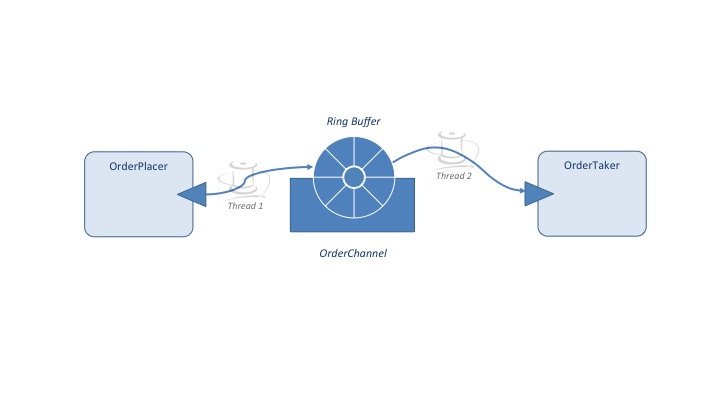Ring Buffer (Disruptor) Channels
Overview
Fabric3 provides support for ring buffer channels based on the LMAX Disruptor. Ring buffer channels are particularly useful in latency-sensitive applications as they reduce contention an unnecessary object allocation. The default channel implementation uses the runtime ExecutorService to schedule asynchronous event dispatch on a pooled thread. Placing work on the ExecutorService pool can result in contention and object creation, which can be prohibitive in the most demanding high performance applications.
Ring buffer channels are designed to avoid contention by placing events on a circular buffer implementation, in this case the LMAX Disruptor. Consumers running on different threads receive events from the buffer.
Using Disruptor-based channels is simple. All that needs to be done is to specify the ring.buffer channel type as shown below:
<composite ...> <channel name="OrderChannel" type="ring.buffer"/> </composite>
No special coding is required for producers and consumers:
public void class OrderPlacer ... {
@Producer(target="OrderChannel")
protected OrderChannel channel;
public void placeOrder(Order order) {
channel.publish(order);
}
}
public void class OrderTaker ... {
@Consumer(source="OrderChannel")
public void onOrder(Order order) {
....
}
}
Configuration
Ring buffer channels have the following configuration options:
ring.size- The number of elements (slots) to create in the ring buffer.wait.strategy- The consumer wait strategy. Valid values are LOCKING, YIELDING, SLEEPING, BACKOFF, SPIN, and TIMEOUT.blocking.timeout- The consumer blocking timeout in nanoseconds.spin.timeout- The consumer spin timeout in nanoseconds.yield.timeout- The consumer yield timeout in nanoseconds.phased.blocking.type- The phased blocking type. Valid values are LOCK and SLEEP.
For more information on these values, refer to the LMAX Disruptor site.
Bindings
Disruptor-based channels may be combined with messaging technologies such as The ZeroMQ Binding to create high performance distributed services. The FastQuote sample application demonstrates using ring buffer channels in conjunction with ZeroMQ and Google Protocol Buffers in a trading application that achieves microsecond processing times. For more details, see the respective binding sections.
Performance Tuning
By default, Fabric3 uses JDK proxies to create producer proxies. JDK proxies are less performant than handwritten code and allocate objects during invocation (for example, an array to create parameter values). Fabric3 provides an optional extension that uses bytecode generation to create proxies. This results in proxies that are as fast as handwritten code and do not allocate objects during invocation. To enable bytecode generation, the fabric3-bytecode-proxy module must be installed in the runtime. Its dependency coordinates are org.fabric3:fabric3-bytecode-proxy.
Advanced Features
Ring buffer channels support a number of advanced features included ordered consumers, worker pools, and batching. Note that the channels sample application provides examples of these advanced features.
Ordered Consumers
The @Consumer annotation contains the sequence attribute. A sequence may be used to specify the order in which a consumer should receive messages. For example, if a channel has three consumers and one of the consumers must be called first, it must specify a lower sequence number than the others (the default sequence number is 0):
public class Deserializer {
@Consumer (sequence = 0)
public onOrder(ChannelEvent event) {
...
}
}
public class OrderTaker {
@Consumer (sequence = 1)
public onOrder(ChannelEvent event) {
...
}
}
Specifying a sequence is useful to perform tasks such as deserializing, replication, and journaling. In the above example, a deserializer is called before the OrderTaker consumer. Notice that the parameter type is org.fabric3.api.ChannelEvent, which is a specialized type:
public interface ChannelEvent {
/**
* Returns the raw event.
*
* @return the event
*/
<T> T getEvent(Class<T> type);
/**
* Returns the parsed event if applicable; otherwise null.
*
* @return the parsed event or null
*/
<T> T getParsed(Class<T> type);
/**
* Sets the parsed event.
*
* @param parsed the event
*/
void setParsed(Object parsed);
/**
* Returns true if the event is an end of batch.
*
* @return true if the event is an end of batch.
*/
boolean isEndOfBatch();
/**
* Returns the event sequence number or -1 if not defined.
*
* @return the sequence number or -1
*/
long getSequence();
}
If one consumer needs to modify the event for subsequent consumers (such as a deserializer), they must accept type ChannelEvent. As shown above, that type contains fields for reading the raw event and setting a parsed (or modified value).
Worker Pools
Sometimes it is beneficial to have a pool of consumers that accept messages from a ring buffer channel. The ChannelEvent type provides access to the message sequence number, which can be used to determine whether a worker should process or ignore the request (effectively creating a worker pool). This can be done using a modulo operation:
public class PooledWorker {
@Monitor
protected SystemMonitor monitor;
@Property
protected int ordinal;
@Property
protected int numberOfConsumers;
@Consumer
public void onEvent(ChannelEvent event) {
if ((event.getSequence() % numberOfConsumers) != ordinal) {
// ignore the event if it is not for this consumer
return;
}
String message = event.getEvent(String.class);
monitor.process(ordinal, message);
}
}
Batching
In many situations batching provides significant performance gains when writing to a database, a file or a network socket. The ChannelEvent type provides an isEndOfBatch method which can be used to determine when the end of a batch has been received so that a flush operation can be issued.
